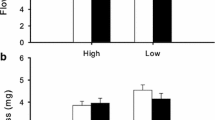Abstract
The sex expression inThymelaea hirsuta was assessed in five habitats in the western Mediterranean desert of Egypt. The survey over two main flowering periods indicated that the sexual expression of this plant is complex and labile. Beside the dioecious male and female states, five monoecious states were detected. The dioecious states are more abundant and less labile. There is a clear shift from monoecious towards dioecious states and in general favour of males from the first (late autumn) to the second (late winter) flowering period. These results are discussed in view of the adaptive theories and evolution.
Similar content being viewed by others
References
Abdel-Razik, M. S., 1980: A study of productivity and nutrient turn-over of some common plant species in the Western Mediterranean Desert of Northern Egypt. — Ph.D. Thesis, Bot. Dept., Fac. Sci. Alexandria University.
Allen, S. E., Grimshaw, H. M., Parkinson, J. A., Quarmby, C., 1974: Chemical analysis of ecological materials. — London: Blackwell Scientific Publications.
Bawa, K. S., 1980: Evolution of dioecy in flowering plants. — Ann. Rev. Ecol. Syst.11: 15–39.
—, 1981: Evolution of sexual systems in flowering plants. — Ann. Missouri Bot. Gard.68: 254–274.
Betremieux, R., 1948: Traité de chimie vegetale. Publié sous la direction de Brunel, Id. p. 342 (in Espiau, Pet Larguier, M. 1967).
Denelle, N., Dommeé, B., Bompar, J. L., 1987: Changements de sexe et polymorphisme sexual chezThymelaea hirsuta (L.)Endl. (Thymelaeaceae). — Compt. Rend. Acad. Sci. Paris304: 407–411.
Dommeé, B., Bompar, J. L., Denelle, N., 1990: Sexual tetramorphism inThymelaea hirsuta (Thymelaeaceae): evidence of the pathway from heterodichogamy to dioecy at the infraspecific level. — Amer. J. Bot.77: 1449–1462.
—, 1984: Proportions des sexes dans deux populations francaises deThymelaea hirsuta (L.)Endl. — Bull. Soc. Bot. France131: 201–205.
El-Ghonemy, A. A., Shaltout, K., Valentine, W., Wallace, A., 1977: Distributional pattern ofThymelaea hirsuta (L.)Endl. and associated species along the Mediterranean coast of Egypt. — Bot. Gaz.138: 479–489.
Emberger, L., 1955: Une classification biogéographiques des climats. — Recueil de Travaux de Laboratoires de Botanique, Geologie et Zoologie, Fac. Sci. Univ. Montpellier7: 3–43.
Freeman, D. C., Harper, K. T., Charnov, E. L., 1980: Sex change in plants: old and new observations and new hypotheses. — Oecologia47: 222–232.
—, 1976: Differential resources utilization by the sex of dioecious plants. — Science193: 597–599.
—, 1981: Influence of environment on the floral sex ratio of monoecious plants. — Evolution35: 194–197.
Heslop-Harrison, J., 1957: The experimental modification of sex expression in flowering plants. — Biol. Rev. (Cambridge)32: 38–90.
Kalmus, H., Smith, C. A. B., 1960: Evolutionary origin of sexual differentiation and the sex ratio. — Nature186: 1004–1006.
Kit Tan, 1980: Studies in theThymelaeaceae. II. A revision of the genusThymelaea. — Notes Roy. Bot. Gard. Edinburgh38: 189–246.
Lloyd, D. G., 1980: The distribution of gender in four angiosperm species illustrating two evolutionary pathways to dioecy. — Evolution34: 123–134.
—, 1977: Secondary sex characters in seed plants. — Bot. Rev.43: 177–216.
—, 1984: Modification of the gender of seed plants in varying conditions. — Evol. Biol.17: 255–338.
McArther, E. D., 1977: Environmentally induced changes of sex expression inAtriplex canescens. — Heredity38: 97–103.
Meigs, P., 1973: World distribution of coastal deserts. — InDavis, H. K., Amiran, Wilson, A. Z., (Eds.): Coastal desert: their natural and human environments, pp. 3–13. — Arizona: University of Arizona Press.
Shaltout, K. H., 1987: Pattern, phenology and sex ratio of EgyptianThymelaea hirsuta populations. — Vegetatio72: 67–73.
—, 1988: Structure and standing crop of EgyptianThymelaea hirsuta populations. — Vegetatio74: 67–73.
Waser, N. M., 1984: Sex ratio variation in populations of a dioecious desert perennialSimmondsia chinensis. — Oikos42: 343–348.
Williams, C. N., Thomas, R. L., 1970: Observations on sex differentiation in the oil palm,Elaeis guineensis L. — Ann. Bot.34: 957–963.
Wilson, M. F., 1983: Plant reproductive ecology. — New York: Wiley.
Zohary, M., 1972: Flora Palaestina. — The Israel Academy of sciences and humanities.
Author information
Authors and Affiliations
Rights and permissions
About this article
Cite this article
Shaltout, K.H., El-Keblawy, A.A. Sex expression in EgyptianThymelaea hirsuta (Thymelaeaceae) populations. Pl Syst Evol 181, 133–141 (1992). https://doi.org/10.1007/BF00937440
Received:
Revised:
Accepted:
Issue Date:
DOI: https://doi.org/10.1007/BF00937440




